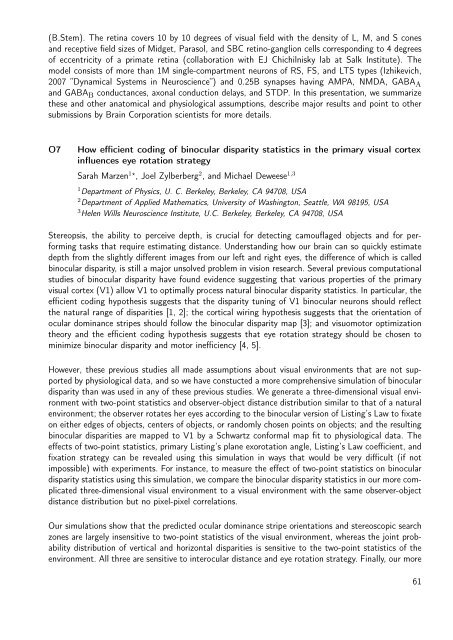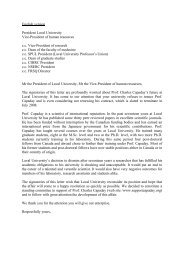Untitled - Laboratory of Neurophysics and Physiology
Untitled - Laboratory of Neurophysics and Physiology
Untitled - Laboratory of Neurophysics and Physiology
You also want an ePaper? Increase the reach of your titles
YUMPU automatically turns print PDFs into web optimized ePapers that Google loves.
(B.Stem). The retina covers 10 by 10 degrees <strong>of</strong> visual field with the density <strong>of</strong> L, M, <strong>and</strong> S cones<br />
<strong>and</strong> receptive field sizes <strong>of</strong> Midget, Parasol, <strong>and</strong> SBC retino-ganglion cells corresponding to 4 degrees<br />
<strong>of</strong> eccentricity <strong>of</strong> a primate retina (collaboration with EJ Chichilnisky lab at Salk Institute). The<br />
model consists <strong>of</strong> more than 1M single-compartment neurons <strong>of</strong> RS, FS, <strong>and</strong> LTS types (Izhikevich,<br />
2007 ”Dynamical Systems in Neuroscience”) <strong>and</strong> 0.25B synapses having AMPA, NMDA, GABA A<br />
<strong>and</strong> GABA B conductances, axonal conduction delays, <strong>and</strong> STDP. In this presentation, we summarize<br />
these <strong>and</strong> other anatomical <strong>and</strong> physiological assumptions, describe major results <strong>and</strong> point to other<br />
submissions by Brain Corporation scientists for more details.<br />
O7<br />
How efficient coding <strong>of</strong> binocular disparity statistics in the primary visual cortex<br />
influences eye rotation strategy<br />
Sarah Marzen 1⋆ , Joel Zylberberg 2 , <strong>and</strong> Michael Deweese 1,3<br />
1 Department <strong>of</strong> Physics, U. C. Berkeley, Berkeley, CA 94708, USA<br />
2 Department <strong>of</strong> Applied Mathematics, University <strong>of</strong> Washington, Seattle, WA 98195, USA<br />
3 Helen Wills Neuroscience Institute, U.C. Berkeley, Berkeley, CA 94708, USA<br />
Stereopsis, the ability to perceive depth, is crucial for detecting camouflaged objects <strong>and</strong> for performing<br />
tasks that require estimating distance. Underst<strong>and</strong>ing how our brain can so quickly estimate<br />
depth from the slightly different images from our left <strong>and</strong> right eyes, the difference <strong>of</strong> which is called<br />
binocular disparity, is still a major unsolved problem in vision research. Several previous computational<br />
studies <strong>of</strong> binocular disparity have found evidence suggesting that various properties <strong>of</strong> the primary<br />
visual cortex (V1) allow V1 to optimally process natural binocular disparity statistics. In particular, the<br />
efficient coding hypothesis suggests that the disparity tuning <strong>of</strong> V1 binocular neurons should reflect<br />
the natural range <strong>of</strong> disparities [1, 2]; the cortical wiring hypothesis suggests that the orientation <strong>of</strong><br />
ocular dominance stripes should follow the binocular disparity map [3]; <strong>and</strong> visuomotor optimization<br />
theory <strong>and</strong> the efficient coding hypothesis suggests that eye rotation strategy should be chosen to<br />
minimize binocular disparity <strong>and</strong> motor inefficiency [4, 5].<br />
However, these previous studies all made assumptions about visual environments that are not supported<br />
by physiological data, <strong>and</strong> so we have constucted a more comprehensive simulation <strong>of</strong> binocular<br />
disparity than was used in any <strong>of</strong> these previous studies. We generate a three-dimensional visual environment<br />
with two-point statistics <strong>and</strong> observer-object distance distribution similar to that <strong>of</strong> a natural<br />
environment; the observer rotates her eyes according to the binocular version <strong>of</strong> Listing’s Law to fixate<br />
on either edges <strong>of</strong> objects, centers <strong>of</strong> objects, or r<strong>and</strong>omly chosen points on objects; <strong>and</strong> the resulting<br />
binocular disparities are mapped to V1 by a Schwartz conformal map fit to physiological data. The<br />
effects <strong>of</strong> two-point statistics, primary Listing’s plane exorotation angle, Listing’s Law coefficient, <strong>and</strong><br />
fixation strategy can be revealed using this simulation in ways that would be very difficult (if not<br />
impossible) with experiments. For instance, to measure the effect <strong>of</strong> two-point statistics on binocular<br />
disparity statistics using this simulation, we compare the binocular disparity statistics in our more complicated<br />
three-dimensional visual environment to a visual environment with the same observer-object<br />
distance distribution but no pixel-pixel correlations.<br />
Our simulations show that the predicted ocular dominance stripe orientations <strong>and</strong> stereoscopic search<br />
zones are largely insensitive to two-point statistics <strong>of</strong> the visual environment, whereas the joint probability<br />
distribution <strong>of</strong> vertical <strong>and</strong> horizontal disparities is sensitive to the two-point statistics <strong>of</strong> the<br />
environment. All three are sensitive to interocular distance <strong>and</strong> eye rotation strategy. Finally, our more<br />
61



